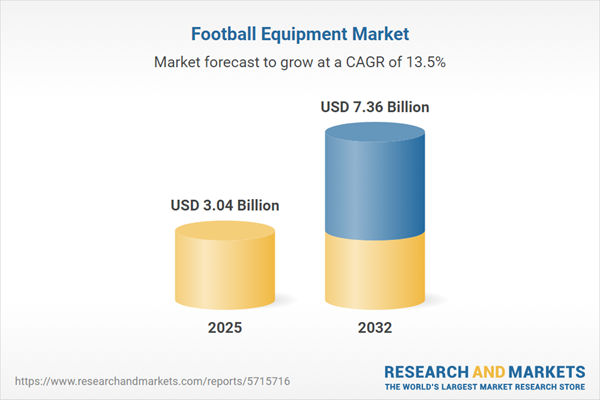Speak directly to the analyst to clarify any post sales queries you may have.
Senior decision-makers navigating the football equipment market are facing rapid industry evolution driven by shifting consumer demands, digital transformation, and intensified global competition. This environment requires targeted intelligence to support sustainable strategy, operational resilience, and growth planning.
Market Snapshot: Football Equipment Market Size and Growth Dynamics
The global football equipment market is experiencing notable expansion, with value projected to rise from USD 2.67 billion in 2024 to USD 3.04 billion in 2025 and reach USD 7.36 billion by 2032. This reflects a robust compound annual growth rate of 13.48%. Growth is primarily fueled by increasing football participation across all age groups and skill levels. Product innovation remains a core driver as brands pursue advanced features tailored to evolving user needs, while digital sales channels continue to extend market reach. The competitive landscape blends established global brands and entrepreneurial entrants competing through adaptive engagement strategies, brand differentiation, and digital-first pathways.
Scope & Segmentation: In-Depth Analysis for Leadership Strategy
- Product Types: Accessories (bags, tapes) streamline gear management, while apparel (jerseys, shorts, socks) improves athlete comfort and supports team identity. Football boots feature both leather and synthetic materials suited to diverse playing conditions. Protective gear such as gloves, headgear, and shin guards enhances safety and regulatory compliance. Training equipment, including cones, dummies, and goals, serves clubs, educational institutions, and self-guided athletes.
- Distribution Channels: Direct sales foster stronger brand-buyer relationships. Online retailers increase reach and simplify procurement. Specialty stores provide expert guidance, and sporting goods outlets offer interactive, in-person product experiences.
- End Users: Amateurs prioritize affordability and ease of use, professionals seek high-performance features, recreational players require adaptable products, and the youth sector presents emerging opportunities for tailored development.
- Regions: The Americas include mature demand in North America alongside developing Latin American markets. Europe features both legacy-driven Western regions and emerging growth in Eastern areas. The Middle East and Africa are expanding through rising participation and infrastructure development, while Asia-Pacific leads in technology adoption and market acceleration.
- Technologies: Innovations in materials improve comfort and equipment lifespan. 3D printing advances facilitate customized, rapid production. Integration of wearable sensors and artificial intelligence enables real-time athlete performance feedback. Digital sales platforms broaden retail capabilities and consumer engagement.
- Leading Companies: Market leaders—Nike, adidas, Puma, Under Armour, New Balance, Mizuno, Uhlsport, Umbro, Joma, and Hummel—utilize global resources and ongoing product development to satisfy diverse customer expectations.
Key Takeaways for Senior Decision-Makers
- Focusing on adaptable product innovation and user-centric design is essential to boost engagement and deliver measurable performance enhancements.
- Supply chain strategies are shifting toward sustainable sourcing and personalized offerings, heightening the importance of agile procurement models.
- Digital-first, direct-to-consumer approaches are allowing brands and new entrants to improve market access, operating margins, and brand loyalty.
- Strategic plans should consider varying regional development, market maturity, and evolving infrastructure to drive effective resource allocation.
- Collaboration between equipment providers and technology firms is rapidly expanding the market for connected and data-integrated products.
- Flexible, responsive operational frameworks enable organizations to navigate dynamic trends, manage disruptions, and accelerate innovation cadence.
Tariff Impact: Navigating Cost and Supply Chain Adaptations in the Football Equipment Market
Upcoming U.S. tariffs in 2025 are expected to place new cost burdens on football equipment production. Organizations are responding by reassessing sourcing strategies, considering options like nearshoring, and diversifying supplier bases to reduce exposure to volatility. Agile inventory management and robust compliance procedures are becoming central to safeguard supply chain stability and meet evolving regulatory demands.
Methodology & Data Sources
This report is informed by interviews with executives, athlete feedback, liaison with regulatory bodies, and comprehensive surveys of manufacturers and distributors. Market intelligence is substantiated through recognized trade publications and official documentation to ensure reliability and market relevance.
Why This Report Matters
- Delivers critical insight into technology adoption, the changing distribution landscape, and key market risk variables in the football equipment industry.
- Supports effective executive planning and investment by offering nuanced, segmented, and region-specific market intelligence.
- Empowers business leaders to align with new digital, regulatory, and consumer trends to maintain competitive standing and strategic perspective.
Conclusion
The football equipment market is most rewarding to organizations that harness strategic adaptability and data-driven planning. Senior leaders using targeted insights are best equipped to pursue new growth and sustain resilience as the industry continues to evolve.
Additional Product Information:
- Purchase of this report includes 1 year online access with quarterly updates.
- This report can be updated on request. Please contact our Customer Experience team using the Ask a Question widget on our website.
Table of Contents
3. Executive Summary
4. Market Overview
7. Cumulative Impact of Artificial Intelligence 2025
List of Figures
Samples

LOADING...
Companies Mentioned
The key companies profiled in this Football Equipment market report include:- Nike, Inc.
- adidas AG
- Puma SE
- Under Armour, Inc.
- New Balance Athletics, Inc.
- Mizuno Corporation
- Uhlsport GmbH
- Umbro International Limited
- Joma Sport, S.A.U.
- Hummel International Sport A/S
Table Information
| Report Attribute | Details |
|---|---|
| No. of Pages | 180 |
| Published | October 2025 |
| Forecast Period | 2025 - 2032 |
| Estimated Market Value ( USD | $ 3.04 Billion |
| Forecasted Market Value ( USD | $ 7.36 Billion |
| Compound Annual Growth Rate | 13.4% |
| Regions Covered | Global |
| No. of Companies Mentioned | 11 |









